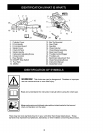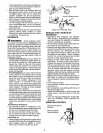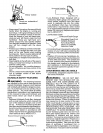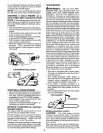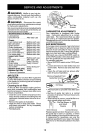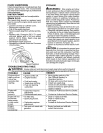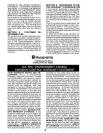
Thereshouldbenosmoking,openflames,
orworkthatcouldcausesparks.AIIowen-
gineto coolbeforerefueling.
• Mixandpourfuelin anoutdoorareaon
bareground;storefuelinacool,dry,well
ventilatedplace;and use an approved,
markedcontainerfor all fuel purposes.
Wipeupallfuelspillsbeforestartingsaw.
• Moveatleast10feet(3meters)fromfuel-
ingsitebeforestartingengine.
• Turntheengineoff andletsawcoolin a
non-combustiblearea,notondryleaves,
straw,paper,etc. Slowlyremovefuelcap
andrefuelunit.
• Storetheunitandfuelinanareawherefuel
vaporscannot reach sparks or open
flamesfromwaterheaters,electricmotors
orswitches,furnaces,etc.
KICKBACK
a_WARNIN_: Avoidkickbackwhich
canresultinseriousinjury.Kickbackis the
backward, upward orsudden forward motion
of the guide bar occurring when the saw
chain near the upper tip of the guide bar con-
tacts any object such as a log or branch, or
when the wood closes in and pinches the
saw chain in the cut. Contacting aforeign ob-
ject in the wood can also result in loss of
chain saw control.
• RotationalKickbackcanoccurwhenthe
moving chain contacts an object at the up-
per tip of the guide bar. This contact can
cause the chain to dig into the object,
which stops the chain for an instant. The
result is a lightning fast, reverse reaction
which kicks the guide bar up and back to-
ward the operator.
• Pinch-Kickbackcan occur when the the
wood closes in and pinches the moving
saw chain in the cut along the top of the
guide bar and the saw chain is suddenly
stopped. This sudden stopping of the
chain results in a reversal of the chain
force used to cut wood and causes the
sawto move inthe oppositedirectionofthe
chain rotation. The saw is driven straight
back toward the operator.
• Pull-In can occur when the moving chain
contacts a foreign object in the wood in the
cut along the bottom of the guide bar and
the saw chain is suddenly stopped. This
sudden stopping pulls the saw forward and
away from the operator and could easily
cause the operator to lose control of the
saw.
Avoid Pinch-Kickback:
• Be extremely aware of situations or ob-
structions that can cause material to pinch
the top of or otherwise stop the chain.
• Do not cut more than one log at a time.
• Do not twist the saw as the bar is with-
drawn from an undercut when bucking.
Avoid Pull-In:
• Always begincuttingwiththeengineatfull
speed and the saw housing against wood.
• Use wedges made of plastic or wood.
Never use metal to hold the cut open.
ack Path
Avoid Obstructions
Clear The Working Area
REDUCE THE CHANCE OF
KICKBACK
• Recognize that kickback can happen.
With a basic understanding of kickback,
you can reduce the element of surprise
which contributes to accidents.
• Never let the moving chain contact any ob-
ject at the tip of the guide bar.
• Keep the working area free from obstruc-
tions such as othertrees, branches, rocks,
fences, stumps, etc. Eliminate or avoid
any obstruction that your saw chain could
hit while you are cutting. When cutting a
branch, do not let the guide bar contact
branch or other objects around it.
• Keep your saw chain sharp and properly
tensioned. A loose or dull chain can in-
crease the chance of kickback occurring.
Follow manufacturer's chain sharpening
and maintenanceinstructions. Checkten-
sion at regular intervals with the engine
stopped, never with the engine running.
Make sure the bar clamp nuts are securely
tightened after tensioning the chain.
• Beginandcontinuecuttingatfullspeed. If
the chain is moving at a slower speed,
there is greaterchance of kickback occur-
ring.
• Cut one log at a time.
• Use extreme caution when re-entering a
previous cut.
• Do not attempt cuts starting with the tip of
the bar (plunge cuts).
• Watch for shifting logs or other forces that
could close a cut and pinch or fall into
chain.
• Use the Reduced-Kickback Guide Bar
and Low-Kickback Chain specified for
your saw.
MAINTAIN CONTROL
Stand to the left of_
the saw
Never reverse
hand positions
4




